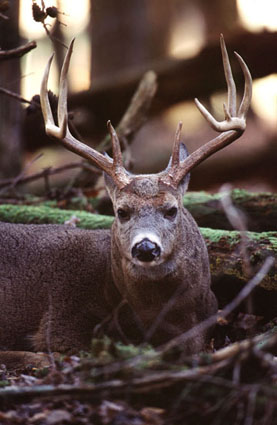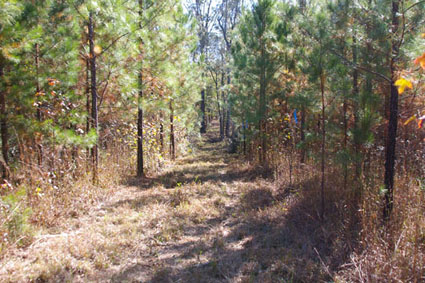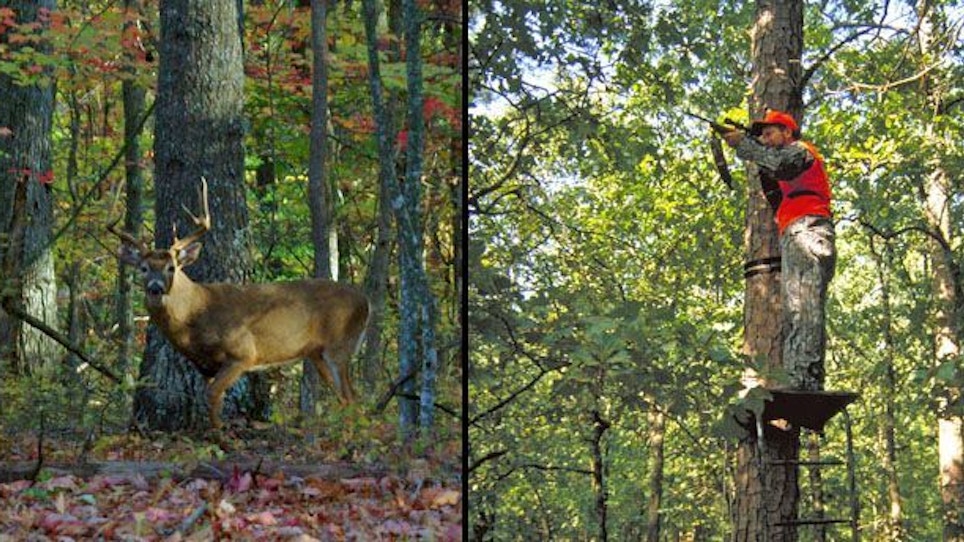 When hunters start stirring, deer, especially big bucks, move to escape areas in dense cover or steep terrain. Courtesy of NC Wildlife |
You’ve found a good hunting locale with a healthy deer population, including some big bucks. Now you must answer a very important question: Where, exactly, will you put your stand?
Choose the right spot and you could see the buck of a lifetime. Select the wrong place and you’ll experience disappointment.
You must scout to determine the ideal stand location, looking for hotspots like these.
Funnels
Always watch for stand sites where terrain features funnel deer through a small area. In farmlands, this often is a tree line or overgrown fence row connecting two tracts of woodlands surrounded by agricultural fields. When a buck moves from the south woods to the north section, it will follow the cover strip and can be intercepted by a watchful hunter in an elevated stand. Other funnels include crossing spots on deep ravines, saddles between ridge peaks, benches on mountainsides, heavy-cover strips between open feeding areas and open paths through clearcuts or thickets.
Active Scrapes
Finding a line of fresh scrapes helps identify a mature buck’s travel route. Putting a stand nearby is definitely worthwhile, but it need not be right on top of a scrape as long as you can cover the route. Use terrain, cover and local wind flows to your maximum advantage when selecting a stand site. For example, predominant winds might not let you kill the buck down in the draw where the biggest scrapes are, but you have a chance up on the ridge where the travel route leads. Study local conditions and place your stand accordingly.
Escape Areas
Each morning when hunters start dispersing en masse into deer territory, deer go where they can avoid humans. These escape areas usually feature dense cover or steep terrain. Situate a tree stand where you can see likely entrance or exit paths and be there watching when other hunters start stirring. Look for rugged cover-filled areas where wary bucks might feel safe: thick creek-bottom brush, hollows full of vines and blowdowns, a bench just below a ridgetop or brushy knolls overlooking feeding areas.
Trails
Heavily used deer trails can be choice hunting spots. For example, one good stand site is where you can watch a trail deer travel between a daytime bedding area in dense cover and a nighttime feeding area such as a crop field. If you’ll hunt more during the morning, it might be best to have a stand closer to the bedding area. That way there’s a better chance you’ll see a deer coming to bed down after the sun is up. If you plan to hunt more in late afternoon, put the stand closer to the feeding area.
Swamps
Lightly hunted swamps often harbor big-racked bucks. An ideal stand site is on a long “ridge” of higher ground deer can travel and keep their feet dry. These aren’t distinct like mountain ridges. They appear as slightly higher elevations on a topo map, often adjacent oxbow lakes or near the swamp’s outer perimeter where lowlands give way to dryer terrain. Scout for crossing places between water bodies, too. For example, a slough connecting two oxbow lakes might have a beaver-dam “bridge” where deer cross, making this a good stand site. Likewise, a narrow spot in an otherwise broad bayou might serve as a travel route, even if deer have to swim across.
 Deer often follow the path of least resistance, traveling through funnels in terrain or cover like this. |
Edge Areas
Deer are edge lovers, often traveling and feeding where two habitat types come together. For example, whitetails are more likely to be seen where a pine planting abuts a hardwood stand rather than deep within the pines or hardwoods themselves, making the edge area best for stand placement. Crop field/woodland edges and edges of rivers and lakes are deer hotspots, too.
Power Or Gas Lines
Rifle hunters love these open areas. They allow long-range viewing and shooting, and can be planted with foods that attract whitetails. A tall stand that allows distant viewing and easy turning to tag a buck from long range is desirable.
Finger Ridges
Place your hand flat on a table. Now spread your fingers. Pretend these are finger ridges coming off a main ridge. The hub — the back of your hand — is where most deer pass through, and you should scout there for a stand location. If the hub is also a nice oak flat with plentiful acorns, that’s a real hotspot. These are definitely places to scout and put a stand if sign indicates deer activity.
Fence Crossings
Deer travel paths of least resistance, so they habitually pass through gaps in fence lines. A concealed stand with a good view of deer crossing here can be a real producer. Find where a tree has fallen across a fence, and you’ve located a blue-ribbon stand site. Deer will jump through repeatedly until the fence gets fixed.
Wooded Points
Strips of brush or trees jutting into feeding fields can be golden stand locations. These often these exist because there’s a draw there or the ground stays wet. Whatever the reason, if you find a place like this, examine it thoroughly. Chances are deer use it to enter and exit the field, and a properly placed stand can help you kill one.






